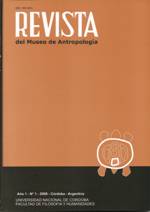How an author becomes. About the cultural contact between cities (Córdoba / Buenos Aires, 1880-1930)
DOI:
https://doi.org/10.31048/1852.4826.v1.n0.5400Keywords:
publishing, the making of the author, cultural contact, cities, nationAbstract
How does one build a history of publishing in the absence of a descriptive, serial or qualitative prehistory? The question characterizes the starting point of all inquiry focusing the ancient world of cordobean booklet, books and magazines; an effort strained between meager local precedents and sophisticated external stimuli. Been that the case, there is no other way than simultaneous elaboration of large maps of the evolution and successive states of that world, and bounded and intensive advances on specially representative or significant cases. Such an advance has begun to clear the instances and modalities of realization of the printed thing in the turn of the century, while throwing a light its heteronomous character. In fact, from the writing stage until the moment of the exhibition in the shopwindows in the form of book, any editorial fact that could be pointed out regarding Córdoba is as much local as porteño or European and should, consequently, be considered on scale adequate to the territoriality of each cultural contact. The making of the author, phenomenon highlighted by the relational consideration and topic of the present article, allows us to appreciate in a very clear way the postulated heteronomy.Downloads
References
Barthes, R. 2003. ‘Écrivains’ y ‘écrivants’. Ensayos críticos, Seix Barral, Buenos Aires.
Bourdieu, P. 2003. Creencia artística y bienes simbólicos. Elementos para una sociología de la cultura, Aurelia Rivera, Córdoba.
Bourdieu, P. 2003. Las condiciones sociales de la circulación de ideas. Intelectuales, política y poder, Eudeba, Buenos Aires.
Cabrera, P. J. 1924. Imprentas e impresos en nuestro pasado. Revista de la Universidad Nacional de Córdoba, Vols. 10 a 12, Córdoba.
Cabrera, P. J. 1930. La segunda imprenta de la Universidad de Córdoba adquirida por suscripción popular en 1823 bajo el Gobierno del Gral. Juan Bautista Bustos, UNC, Córdoba.
Canter, J. 1940. La imprenta. Ricardo Levene (edit), Historia de la Nacion Argentina (Desde los orígenes hasta la organización definitiva en 1862), Vol. IV, El Ateneo, Buenos Aires.
Capdevila, A. 1960. Martín Gil. Ciudadano del cielo. Prólogo a la Antología de Martín Gil, Academia Argentina de Letras, Buenos Aires.
Chartier, R. 1996. El orden de los libros. Lectores, autores, bibliotecas en Europa entre los siglos XIV y XVIII, Gedisa, Barcelona.
Delgado, V., F. Espósito 2006. 1920-1937. La emergencia del editor moderno. José Luis De Diego (dir.), Editores y políticas editoriales en Argentina, 1880-2000, FCE-Libraria, Buenos Aires.
De Ugarteche, F. 1929. La imprenta argentina. Sus orígenes y desarrollo, Canals, Buenos Aires.
Eujanian, A. 2000. La cultura: público, autores y editores. Marta Bonaudo (dir.), Liberalismo, estado y orden burgués (1852-1880), Nueva Historia Argentina, T. IV, Sudamericana, Buenos Aires.
Foucault, M. 1985. ¿Qué es un autor?, Universidad Autónoma de Tlaxcala, México.
Furlong, G. 1924. La imprenta jesuítica de Córdoba. Extracto en Pablo J. Cabrera, «Imprentas e impresos en nuestro pasado», Revista de la Universidad Nacional de Córdoba, Vols. 10 a 12, Córdoba.
Martin, H.-J., L. Febvre 2005. La aparición del libro, FCE-Libraria, México.
Merbilhá, M. 2006. 1900-1919. La época de organización del espacio editorial. José Luis De Diego (dir.), Editores y políticas editoriales en Argentina, 1880-2000, FCE-Libraria, Buenos Aires.
Pastormerlo, S. 2006. 1880-1899. El surgimiento de un mercado editorial. José Luis De Diego (dir.), Editores y políticas editoriales en Argentina, 1880- 2000, FCE-Libraria, Buenos Aires.
Ramos, J. 1989. Desencuentros de la modernidad en América Latina. Literatura y política, FCE, México.
Río, M. 1956 (1910). La imprenta y los periódicos. Córdoba. 1810-1910, reproducido en Córdoba, su fisonomía y su misión. Escritos y discursos, UNC, Córdoba.
Río, M. 1967 (1910). Córdoba, su fisonomía y su misión. Escritos y discursos, UNC, Córdoba.
Roca, D. 1956 (1935). ‘Vidas paralelas’ Historia ejemplar de la Academia Argentina de Letras. El difícil tiempo nuevo, Lautaro, Buenos Aires.
Rolla Bertello, E. 1991. «La biblioteca Dussaut: imprenta e impresores cordobeses del siglo XIX». Facultad de Filosofía y Humanidades. Universidad Nacional de Córdoba, Argentina. Biblioteca Central de la FFyH-UNC.
Sorá, G. 2008a. Le livre et l’édition en Argentine. Livres pour tout le monde et modèle hispano-américain.
Martin Lyons, Jaques Michon, Jean-Yves Mollier y François Valloton (orgs.), Histoire nationale or histoire internationale du livre et de l’édition. Un débat planétaire / National or international boook and publishing history? A worldwide discusión, Nota Bene éditions, Québec. (en prensa).
Sorá, G. 2008b. Misión de la edición para una cultura en crisis. El Fondo de Cultura Económica y el americanismo en Tierra Firme. Carlos Altamirano (Dir.), Entre cultura y política: historia de los intelectuales en América Latina, Katz, Buenos Aires.
Sparn, E. 1924. Las bibliotecas con 50.000 y más volúmenes y su distribución geográfica sobre la tierra. Revista de la Universidad Nacional de Córdoba, Vols. 1 a 3, Córdoba.
Downloads
Published
Issue
Section
License
Those authors who have publications with this Journalaccept the following terms:
a. Authors will retain their copyrights and guarantee the journal the right of first publication of their work, which will be simultaneously subject to the Creative Commons Attribution License (Licencia de reconocimiento de Creative Commons) that allows third parties to share the work as long as its author and his first publication in this journal.
b. Authors may adopt other non-exclusive licensing agreements for the distribution of the version of the published work (eg, deposit it in an institutional electronic file or publish it in a monographic volume) provided that the initial publication in this journal is indicated.
c. Authors are allowed and recommended to disseminate their work on the Internet (eg in institutional telematic archives or on their website) before and during the submission process, which can lead to interesting exchanges and increase citations of the published work. (See The Effect of Open Access - El efecto del acceso abierto)












